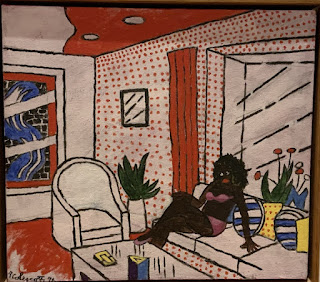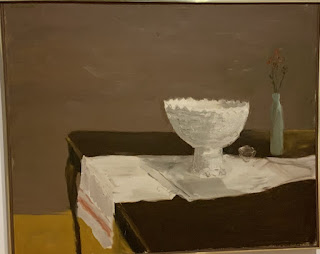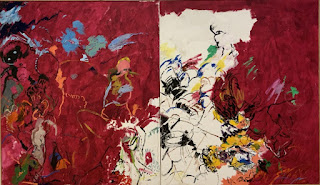School Days , 1988
Robert Colescott (1925-2009) is controversial in the artworld of racial identity probably because he doesn’t really belong there. As he states in an online 1982 interview, his work is "largely about myself and my responses". He was not speaking for the black people of America, as Kerry James Marshall does. He was speaking for his own unique self - which is kinda black, and kinda not. His educated, musician parents passed as white, and he did as well up to the age of 45.
The Chicago exhibit omitted his most outrageous and famous, blackface variation on famous paintings. We’re shown a sketch of “George Washington Carver Crossing the Delaware” - but not the finished painting where Washington’s row boat was filled with demeaning racial stereotypes from the Jim Crow era.
Possibly he wanted Americans to be ashamed of their racist legacy. But just as possibly, this highly educated white-art-world master and university professor was ashamed of the ignorance and clownishness attributed to blacks. He did not offer a positive, Afro-centric identity as did Lawrence, White, Bearden, Motley, and Marshall. His work is satirical of human antics - like Thomas Rowlandson did in the 18th Century - without the cutting racial bitterness of Kara Walker.
As this career retrospective demonstrates, he was an interesting painter even before he began working with racial and gender stereotypes. He had a way of making an ordinary still life or landscape feel fraught with impermanence. A few of his later pieces seem nothing more than jokes or gags - but the six seven foot figure paintings at the center of the exhibition are as thrilling as a wall in the Scuola di San Rocco. Their monumental turbulence demands attention, though the content might be considered more than a little sexist - even if too goofy to be sexually appealing. He likes big fleshy female nudes. One piece depicts the artist himself being distracted by a woman undressing.
The masterpiece in this show is “School Days”. It’s a maelstrom of interacting figures with energy erupting from every corner. The corrupted scale of justice is at the center, balancing cash money against the black man being weighed. But we also note that he has depicted white kids studying hard and graduating while black kids point guns and sell their bodies. So who’s really to blame for the disparity of outcomes? It’s strong colors and boldness reminds me of Jim Dine’s recent work, where recognizable figuration may just have been an excuse for virtuosic abstract expression.
In Chicago, his contemporaries were the Monster Roster, including Leon Golub and Seymour Rosofsky. This is the generation that came of age in the Great Depression and then were sent off to war. Personal pain and confusion seemed to underlie the subject matter of these white Chicago artists. Colescott’ s work is no less personal - but rather than share the pain, he preferred to joke about it. He laughed at racism just as he laughed at sexism. One wonders whether he took anything, other than the effect of paint on canvas, all that seriously.
******************************
******************************
"The specter of the figure in a red sweater in the left of the composition who points a gun at the viewer is a powerful evocation of events that have shaken American society too often over the past few years. Perhaps the alienation that is seen as a cause of school shootings is indicated by the fact that the relationship between the figures is random. Each one of the individual figures seems to be an independent entity absorbed in their individual stories. Scale and perspective are immaterial as we see the large reclining figure with a gun shot wound in his chest to the right The male student nonchalantly points his gun directly outwards towards the spectator to the right the anomalous bicolored female who dominates the space just off center."
The above text, accompanying "School Days" on the wall, appears to be a deliberate misreading as it focuses on the current issue of gun violence in schools while ignoring the contrasting behavior of the white and the black kids being depicted.
The above is far more provocative than anything included in this show. If a white artist had made it, it would be outrageous.
By the way - it was included in some of the other iterations of this traveling exhibition. Possibly those who hung the Chicago show thought that our city was not ready for it.
An impressive wall of seven foot paintings from the eighties - all featuring nude, full bodied women. As with his five wives, not all of the female bodies he paints are white - but most of them are. As with his younger contemporary, Bob Thompson, inter-racial sexual desire was frequently on display.
Olympia, 1959 (after Manet)




























No comments:
Post a Comment